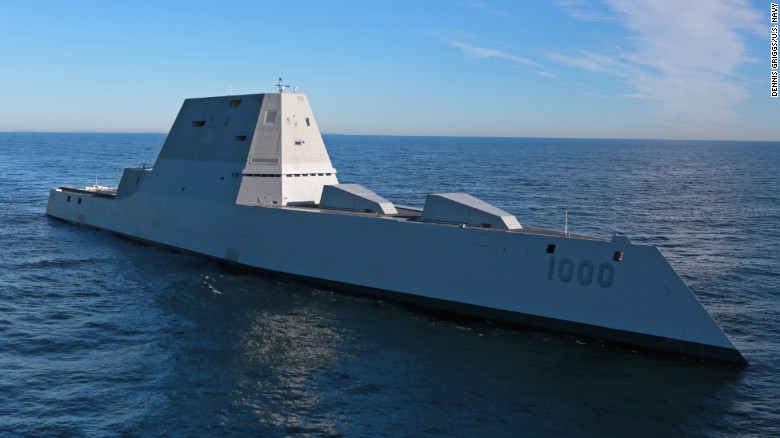The US Navy officially welcomed its largest and most technologically advanced destroyer to the fleet Saturday as the USS Zumwalt was commissioned in Baltimore.
The Zumwalt is striking in appearance, with sharp angles and weaponry concealed behind flat surfaces, a design that makes it many times more difficult to spot on radar than conventional destroyers.
“If Batman had a ship, it would be the USS Zumwalt,” said Adm. Harry B. Harris, Jr., commander of the US Pacific Command, where the ship will be assigned.
The ship also has an advanced power plant and weapon systems that can move the Navy into the future, said Secretary of the Navy Ray Mabus.

“It doesn’t look like other ships and it does things other ships cannot do,” Mabus said.
The ship is named after Adm. Elmo R. “Bud” Zumwalt Jr., a Bronze Star winner from World War II who went on to serve in the Korean and Vietnam wars and as chief of naval operations from 1970 to 1974. His efforts to increase opportunities for minorities and women in the fleet were noted by speakers at Saturday’s commissioning.
“The Navy and the nation are better because of Admiral Zumwalt,” Mabus said Saturday.
A Navy news release raves about the Zumwalt and its two sister ships, the Michael Mansoor and the Lyndon B. Johnson, both under construction at Bath Iron Works in Maine.
Among the things that set the Zumwalt apart from its predecessors in the Arleigh Burke-class of destroyers:
— A larger flight deck that enables operations with new F-35 fighters and MV-22 Osprey tilt-rotor aircraft;
— Larger vertical launch missile tubes that can fire larger and more advanced land attack and anti-ship missiles;
— An electrical power system that generates almost as much electricity as the nuclear power plants on aircraft carriers: “The ship can operate all of its systems and still generate enough electricity to power a small town,” the Navy says,
— The ability, with that extra power, to accommodate weapons of the future, such as electronic rail guns and laser.
But for all that, the Navy plans to buy only the three Zumwalt-class destroyers it has on order, down from 32 originally envisioned early in the program.
The Navy is now focusing on an updated version of the current — and more conventional — Arleigh Burke class.
Bryan Clark, a naval analyst at the Center for Strategic and Budgetary Assessments told USNI News earlier this year that it’s likely the Zumwalt-class ships will be called on for different missions than Burke-class destroyers.
“If you get into a war then you would use it differently than you would a regular (destroyer),” Clark told USNI News.
“They wouldn’t do regular patrols … they would do intelligence-gathering. They would do special ops.”
And some critics wonder if that’s worth the $22.5 billion cost for the three Zumwalt-class ships.
“One US nuclear submarine, the newest in the fleet, costs about $2.2 billion. In other words, they used the budget for two nuclear subs to build one Zumwalt,” one Russian commentator, retired Col. Viktor Baranets, told Russia’s state-run Radio Sputnik earlier this year. “Americans love grandiose projects which sometimes go beyond the scope of reason.”
As reported by CNN
